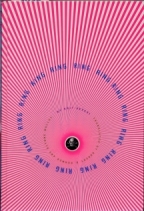Ring
Translated from the Japanese by Robert G. Rohmer and
Glynne Walley
Vertical, Inc
US Hardcover First
ISBN 1-932-23400-4
Publication Date: 04-15-2003
286 Pages; $24.95
Date Reviewed: 06-15-03
Reviewed by: Rick Kleffel © 2003
|

|
|
REFERENCES
|
COLUMNS
|
|
Horror,
Science
Fiction, Mystery
|
07-12-03,
08-22-03
|
Most readers will have first encountered 'Ring' in one of its many
adaptations. It's been a TV mini-series in Japan, a much-bootlegged
Japanese feature recently released on a domestic DVD, and of course a
popular US feature film. Even those who haven't seen the movie know
the clever premise of the story. Now, long after all the filmic forms
have become easily available in the US, the novel has been translated
and published by Vertical-Inc. This is the exact reverse of the usual
order, and common wisdom suggests that while reading a book does not
ruin the enjoyability of a movie, watching a movie adaptation can
definitely destroy the enjoyability of a book.
That's not the case with the story in 'Ring', which like the
message in a game of "Telephone", has been so distorted in each
successive incarnation that it's virtually unrecognizable. Yes,
Suzuki's novel has plenty of surprises for those who have seen both
versions of the movie. The characters, the premise and the conclusion
have all been altered in the film adaptations. Or did you think
horror novels all feature fashion-model beautiful newspaper
reporters? Chip Kidd ('The
Cheese Monkeys') is the art director for Vertical-Inc and his
eye-catching cover alone might make this worthy of purchase.
In Suzuki's novel 'Ring' - the first of a trilogy - the
protagonist is a cranky, overworked young father. Asakawa is so
distracted by his busy life, and a past failure that still haunts
him, that even his niece's death barely registers. But a chain of
chance leads him to discover that another teenager died a similar
death at precisely the same time. Only when his reporterly instincts
are energized does he begin to investigate.
So far, somewhat familiar. But the tone of Suzuki's novel is
vastly different from either movie. He approaches the deadly incident
not as a horror novelist, unearthing a supernatural curse, but as a
mystery or science fiction novelist, connecting clues logically to
eliminate the impossible. No matter how improbable, the deadly
conclusions Asakawa's forced to come to are all that remains. The
first and foremost suspicion is that some sort of virus killed the
teenagers. That proves to be correct but it's not a virus like any
other readers have encountered.
Once Asakawa realizes that he's under a tight and very real
deadline, he employs the help of his old acquaintance Ryuji. Ryuji is
not exactly a friend, but more a forced confidante, who long ago
created an intimate relationship with Asakawa by confessing to
Asakawa that he had raped a girl. The reality of that incident is
disputable, but the effect of the confession is not. Now, Ryuji's
employed as a philosophy professor, and his cynical, scorched-earth
point of view is all that stands between Asakawa and an unpleasant
death. Together they try to find the "charm" that will save
Asakawa.
It's interesting that the solution to the riddle is called a
"charm" here, because the novel itself has not a hint of any
supernatural feeling. This is a cut-and-dried clue-clutching mystery
with subtext to spare that's a joy to read even if you think you know
what's going to happen. More often than not, you won't know, and even
if you do Suzuki's clever plotting and unsympathetic
characterizations will keep you glued to the pages. Readers who enjoy
Stanislaw Lem's mysteries will find much to admire here. There's more
than a hint of M. R. James' scholarly ghost stories, and even
something of Chuck Palahniuk's relentless media-drone to be found in
'Ring' as well. The sum is definitely more than the whole of the
parts. It's a compelling, thought-provoking page-turning reading
experience.
This is not to say that 'Ring' is without problems. As one would
expect, occasionally the prose can get on the clunky side as the
wheels of translation catch on cultural idioms. But by and large, the
translators, Robert G. Rohmer and Glynne Walley have done an
excellent job. They create a unique sense of unease that's utterly
unlike what you'll find in any horror written in English.
Suzuki himself tends towards the expository. Now that's not
surprising, given that the novel operates a bit like a Conan Doyle
mystery, with Ryuji playing the part of Holmes to Asakwa's Watson.
But Suzuki is plowing a path that nobody else has traveled, as his
'Ring'-virus is born into an all-too vulnerable world. There are so
many extremely clever riffs that never made it into either movie that
readers aren't likely to notice how wide the road recently traveled
is until they catch their breath and manage to look back. By the time
that happens, it's far too late. Readers will want to read the next
book in this series with a palpable addictive twinge. The good news
is that translations of both sequels are in the works, and the
following two are likely to make it here before any of the movies do.
Readers can then enjoy the additional pleasure of knowing how much
better the book is before they see the movie rather than after.
